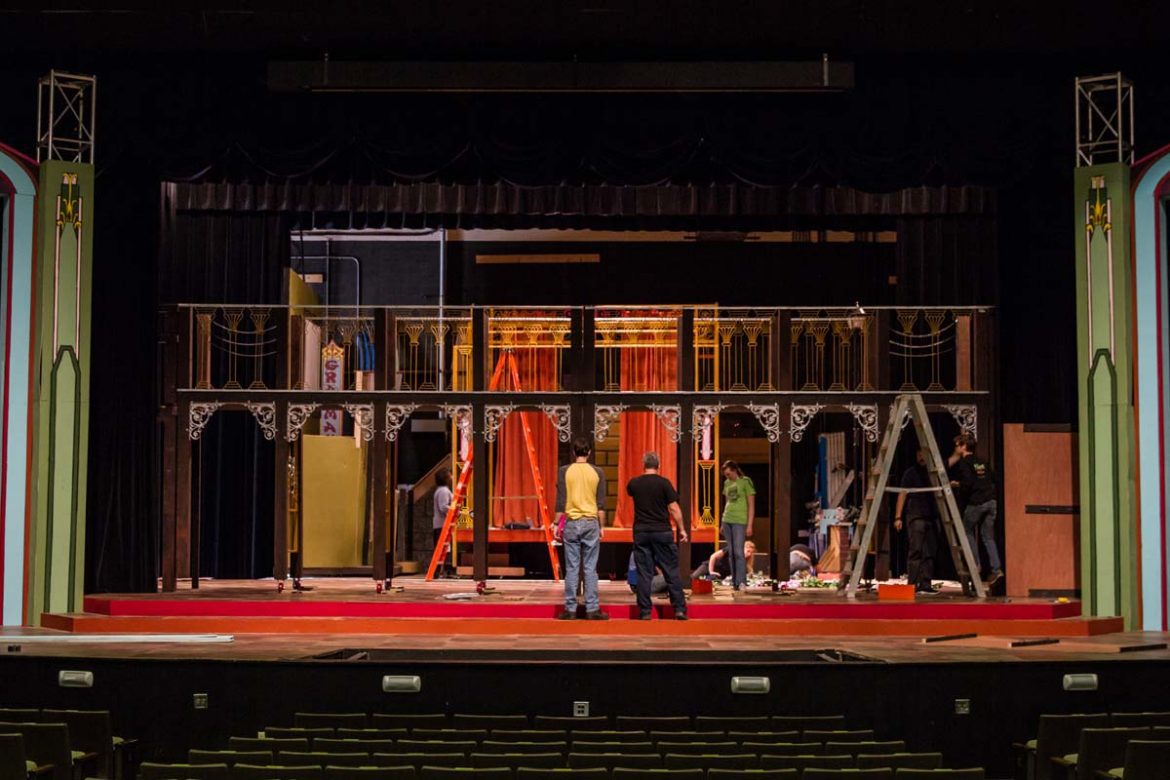During this year’s Homecoming musical, the Benson stage will be showered with technological effects — literally.
This year’s production of “Singin’ in the Rain” will feature a rain machine that will sprinkle the stage with water as cast members perform.
Chair of the Theatre Department Robin Miller said the machine is directly connected to the Benson’s plumbing system and is designed to splash only the stage, not the audience.
“Making the Benson stage get wet without soaking everyone in the audience has been a lot of fun,” Miller said.
A drain built into the stage floor will remove excess water from the stage for the remainder of the show. Miller said the rest of the set is equally detailed, and contains many metal components.
“This is the most steel we have ever put into a set,” Miller said.
Miller said approximately 125 students have worked together to create the set. Students and faculty are normally responsible for sewing, painting and building, but this year students were also taught to weld to create the numerous metal pieces.
“We are educational theater: that’s what we do,” Miller said.
The show also features four silent films created by senior electronic media production major Ethan Sneed. According to Miller, each of the films is significant to the plot, because the show itself is centered around the advent of talking pictures in the 1920s.
Sneed said he drew inspiration from the film production of “Singin’ in the Rain” and old silent films created by Charlie Chapman, one of his heroes.
“How you tell stories with silent film is very different,” Sneed said. “I don’t think I could have done these pieces without realizing that. The thing that helped me the most was piecing together the relationship between the films and what is going on onstage.”
According to Sneed, the films took approximately one month to film and edit. Sneed said although he has made films of his own in the past, using a professional script and working with trained actors gave him a new perspective on filmmaking.
“The real difference for me was working with real actors — people who are deeply involved with the theatre department.,” Sneed said. “That was eye-opening for me.”
Sneed said one of the biggest challenges was editing the films so that they looked old-fashioned. He said he used a variety of effects to create the grainy quality of old film and the choppiness caused by using less frames per second.
In order to make the films as realistic as possible, Events Specialist and Head of Audio Works David Robison recreated or composed original scores for the films and recorded them himself using his electronic keyboard. Robison said he was excited to volunteer to his talents to the musical.
“Creating underscore for video is something I really enjoy doing,” Robison said. “I eagerly accepted the challenge.”
Robison said he has always had a passion for music, and he is not new to writing original scores. Robison used to be part of a video and music production team based in Little Rock, Arkansas, and has contributed to several university productions in the past.
“I started with a waltz idea and made it the main theme because it seemed to fit the time period of the silent movie era,” Robison said. “The composition process began by writing and recording the basic piano score using a multi-track computer program. I then began laying orchestration under the piano track to create a fuller sound. Everything is arranged, recorded and mixed on the computer with a digital piano keyboard as the input device.”
Robison is also responsible for the live audio mixing during the musical, which includes 46 channels of wireless microphones and the orchestra. He said this job involves constantly turning multiple knobs to ensure sound levels are balanced.
“It is great seeing how the process all comes together and to be a part of an experience that involves so many wonderful and talented people to work with, both on the stage and in the production team,” Robison said. “At this point, my main goal is to make everything sound as good as possible, and, of course, to keep the microphones from getting wet.”
